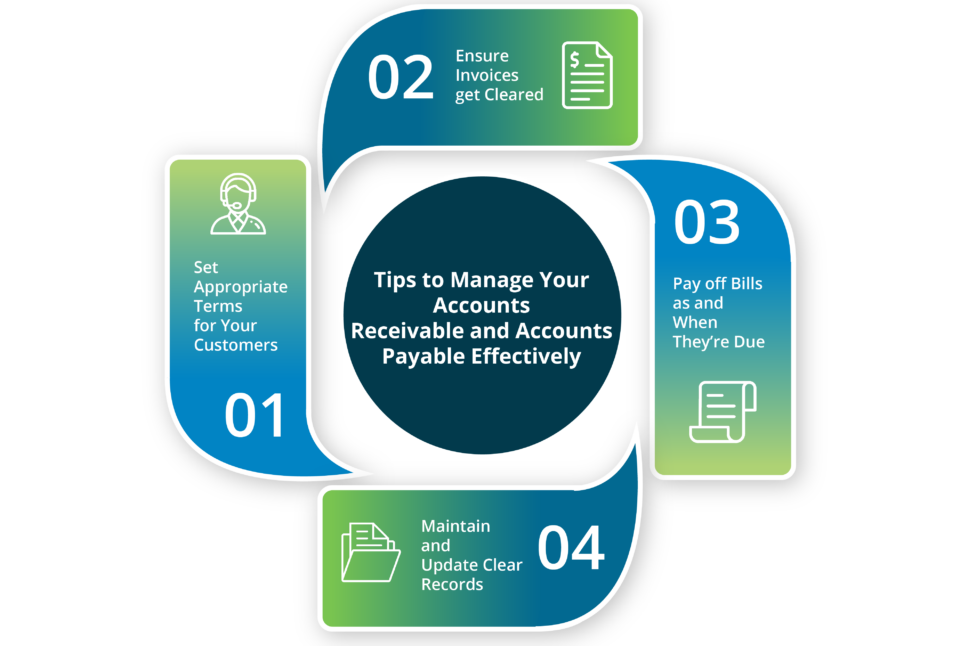Accounts Payable (AP) and Accounts Receivable (AR) are two fundamental accounting functions required by any process manufacturer doing business in today’s world economy. AR activities are key last steps in one’s ‘Order to Cash’ process, and AP activities are key last steps in one’s ‘Procure to Pay’ process. Real-time management of AP and AR records using a financial software application helps process manufacturers manage their cash flow, provides users with a real-time, accurate view of the financial ‘health’ of their business, and enables managers to make quicker, more informed, business decisions.
Accounts Payable
Accounts payable (AP) is a liability account that keeps track of money that you owe to any third party. These can be considered short-term liabilities for any banks, companies, or any person from whom you have borrowed money from a business perspective.
It begins with enrooting supply requirements from within the organization and making quotes from vendors for the required items. After proper negotiation, the purchase orders can be sent and prepared effectively. The goods delivered are inspected upon arrival and the invoice received can be routed for approval. After this, the invoice data needs to be matched with delivery reports and other documents. Then, as a final step, it is coded into the correct ledger, and payments are disbursed according to the terms and conditions.
With accounts payable, organizations can check the actual scenario of the business. It includes all the details of whom and when the payment needs to be paid. It eradicates any chances of delayed payments, overdue bills, late fees, and such circumstances.
A few essential AP Software functions supported by an ERP solution include:
- Vendor management of preferred vendors and their contacts, available products, pricing, discounts
- Vendor payments involves the auto generation of and tracking of vendor payments
- Credit card management & tax liability
- Analysis, collaboration & reporting tools
Accounts Receivable
As the name depicts, accounts receivable (AR) are assets that help in keeping track of money that third parties owe to you. It is considered an asset that can be turned and used in the future. Tracking accounts receivable also becomes crucial when you already have investors, or you are thinking of borrowing money from other sources. The account receivable will help you understand how much money you are going to receive and based on that level what amount of money you can borrow from third parties.
AR also helps with short-term financing at the time of cash flow problems. Businesses can sell outstanding invoices for a fixed percentage of the original invoice amount, yielding greater potential to your short-term cash flow financing needs.
Manufacturing starts with assessing the credit risk of a customer and validating whether they are fit for your company. After the processing of purchase orders, the goods or services get delivered along with the invoices sent to the customers. You then need to make sure that you follow up, collect the payments, identify deductions, and reconcile these payments with the right invoice.
A few essential AR Software functions supported by an ERP solution include:
- Customer Management of customers and their contacts, frequently purchased products, pricing, discounts
- Customer Invoicing involves the auto generation of and tracking of customer invoices
- Credit Card Management & Taxation
- Analysis, Collaboration & Reporting Tools
Day-to-Day Accounting Responsibilities
AR ensures that customers are properly billed for goods and/or services, ensure that the correct amounts are collected in a timely manner, verify and record transactions, resolve account discrepancies, and perform other tasks to secure customer payments.
AP receives, open and log invoices, and ensures that the company’s bills are valid amounts charged by its vendors and that they are paid on time.
AR and AP staff rely on their financial software to provide them with these basic functions:
 Real-time, Update to Date Record Keeping
Real-time, Update to Date Record Keeping
It is necessary to keep records of your income and expenses while ensuring you run a successful business. It also helps in maintaining records of financial statements, and it is important when it comes to official or legal purposes, making it simple while monitoring your business cash flow.
Tracking and managing all your bills and invoices can be difficult manually. If your pending invoices are taking more time, there are fewer chances of getting paid. Make sure that you collect payments from your clients for invoiced amounts, it will help clear your dues. Overdue invoices with a high AR create cash flow problems, impacting your business in negative ways, where all the amounts turn into paying for your bills.
 Comprehensive Reports
Comprehensive Reports
Various accounting systems provide access to automatically generate reports for all the transactions going in and out of the company finance. It helps to have an overall understanding of how the business is going, and in which areas you need to improve to perform efficiently.
 Helpful Reminders
Helpful Reminders
Sometimes the clients forget to make the payment on the due date, with a proper accounting system, you can remind your clients to set the payment on time. Likewise, if you forget to pay the bill for your liabilities, maintaining accounts payable can remind you the same way.
 Flexible Payment Methods
Flexible Payment Methods
With several payment integration platforms, it is easier to ensure that your customers get the benefit of choosing their preferred payment mode. It proves to be helpful to clarify payments on time in both AP’s and AR’s circumstances.
Follow these simple tips to manage your day-to-day accounting responsibilities:
Software Features to Streamline the Accounts Payable and Accounts Receivable Processes
Process Manufacturing ERP applications offer business greater visibility to real-time warehousing and manufacturing-related data which can expediate the ‘Order to Cash’ and ‘Procure to Pay’ processes. In addition to ‘On the Spot’ updates to the AR and AP records, leading Process Manufacturing ERP applications can automate many of the daily accounting tasks using these features:
- Automation – Send reminders, setup auto payments and more
- Alerts – Notify staff when there are issues with late payments and other critical conditions
- Dashboards – Take advantage of role-based dashboards with interactive charts, table, short cuts, and other widgets
- Searches – Use Google like searches to find specific records within the AP and AR records
- Mapping – Use graphical mapping tools to track and trace all documents and records in the ‘Order to Cash’ and ‘Procure to Pay’ processes
- Integrations – Take advantage of leading vendors applications that enhance and extend one’s ERP capabilities through Automated Credit Card & ACH payments, International Taxation Tables, and more.
- Collaboration – Manage communications, including emails, with customer and vendor contacts
BatchMaster ERP for Process Manufacturers
BatchMaster ERP is an end-to-end ERP solution specifically designed for food, chemicals, nutraceuticals, and live sciences manufacturers. Our SAP OEM solution is built upon the SAP Business One platform, which as a leading global SME solution, offers process manufacturers the latest in AR and AP software capabilities.
FAQ
What are accounts payable and receivable?
Accounts payable and accounts receivable are two fundamental aspects of any process manufacturing company’s business. The accounts receivable processes target the ‘Order to Cash’ services and the accounts receivable processes target the ‘Procure to Pay’ services.
What are examples of accounts payable and accounts receivable?
Examples of accounts payable and receivable include, say, a food manufacturing company orders ingredients. The payment due on that date is considered accounts payable. In accounts receivable, company A provides roof cleaning services to company B. Company B’s roof cleaning payments to company A will be considered accounts receivable.
What is the difference between accounts payable and accounts receivable?
A company’s accounts payable (AP) ledger lists short-term liabilities and debt obligations to creditors for goods purchased from suppliers. Accounts receivable (AR) are funds the company receives from its customers and partners.


